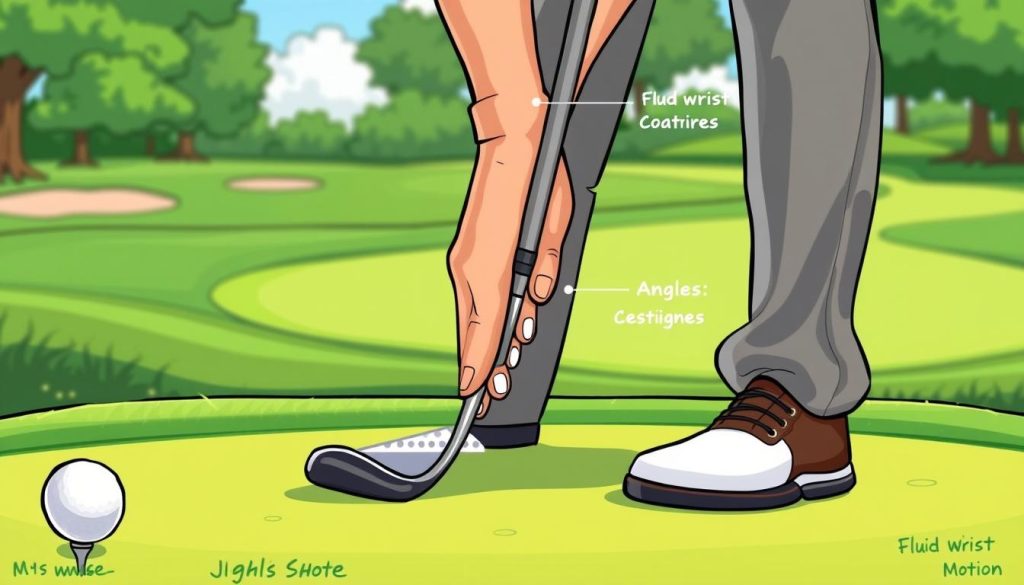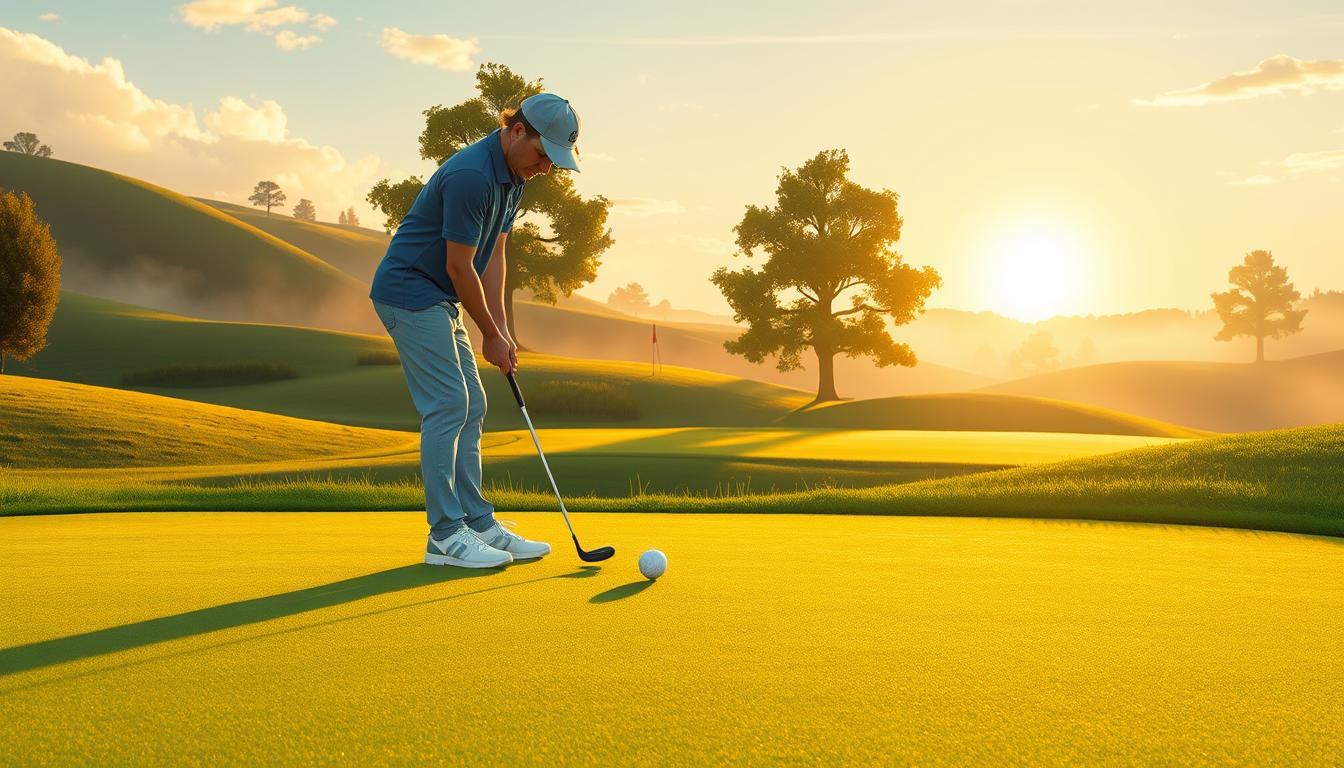Mastering your putting stroke is crucial for improving your golf game. This guide will teach you essential putting techniques. You’ll learn how to perfect your stroke, read greens, and boost your confidence on the green.
Golf is more than just long drives; it’s the short game that matters most. Putting makes up nearly half of all strokes in a typical game. By improving your putting stroke, you can lower your score and elevate your game.
This guide covers everything from choosing the right putter to advanced green-reading techniques. You’ll learn how to pick the perfect putter length and master the pendulum action. We’ll also show you how to develop a preshot routine that suits you.
We’ll discuss the importance of grip pressure and follow-through for consistent, accurate putts. Plus, we’ll explore advanced techniques like green mapping and AimPoint to enhance your putting skills.
Key Takeaways
- Putting makes up nearly half of all strokes in a typical golf game
- Proper putter selection is crucial for improving your putting stroke
- Mastering the pendulum action is key to a consistent putting stroke
- Developing a preshot routine can boost confidence and consistency
- Light grip pressure and firm wrists during follow-through are essential for accurate putts
- Advanced techniques like green mapping and AimPoint can further improve your putting skills
Understanding the Fundamentals of Putting
Improving your golf game starts with mastering putting fundamentals. The putting stroke is key, covering grip, stance, aim, and stroke. Let’s explore the science and mechanics of a perfect putt.
The Science Behind a Perfect Putt
Putting science is about balance in alignment, direction, and speed. Grip stability is crucial for efficient energy transfer. Try different grip styles to find what works best for you.
Key Components of Putting Mechanics
Several factors are essential in golf putting mechanics:
- Proper stance: Feet shoulder-width apart, knees slightly bent, shoulders squared, head centered
- Accurate aim: Essential for controlling direction and speed
- Smooth stroke: Focus on hand control and square clubface alignment
- Consistency: Maintain a steady grip and smooth follow-through
Impact of Green Conditions on Putting
Green conditions greatly impact your putting. Knowing about slope, grain, and speed is vital. Practice reading greens in different conditions to enhance your skills.
| Drill | Distance | Focus |
|---|---|---|
| Putting Gate | 4 feet | Short strokes on level lie |
| Golf Tee | 4 feet | Firm, straight hits |
| Four Corners | 4 feet | Varying positions around hole |
| Ladder | 3, 6, 9 feet | Consecutive putts at each distance |
| Lag Putts | 25 feet | Accuracy and adjustments |
By focusing on these fundamentals and practicing, you’ll see big improvements. Remember, consistency is key to mastering putting.
Putting Stroke Routines Guide
Mastering putting stroke routines is key for golf putting practice and stroke improvement. About 40% of golf games are spent on putting. Improving your skills can greatly affect your performance.
Good putting stroke routines focus on being consistent, not perfect. They include controlling wrist motion, keeping a natural arc, and mastering speed, length, and tempo. Adding these to your practice can improve your stroke and lower your scores.
Stats show the average amateur male golfer puts about 40 times per round. Cutting down 2-4 putts can make a big difference. Aim to get shots within 10 feet, ideally 5 feet, of the hole.
Confidence is crucial for putting success. Practice these routines to build your skills and confidence:
- Use a putting mirror to self-correct alignment and stance
- Practice proper ball roll techniques
- Refine your stroke techniques
- Work on speed control
- Practice sinking putts from various distances
Remember, uphill putts are easier to control than downhill ones. Use this knowledge to improve your stroke on the green.
| Skill | Benefit |
|---|---|
| Alignment | Improves accuracy |
| Stroke length consistency | Enhances distance control |
| Proper tempo and rhythm | Increases overall consistency |
| Face control | Ensures square impact |
By spending time on these routines and practice, you’ll become a more confident and skilled putter. As Willie Park Sr. said, “A good putter is a match for anyone.” With consistent practice and the right techniques, you can greatly improve your putting and golf game.
Mastering Green Reading Techniques
Green reading techniques are key to great putting. Knowing how a green works can really help your game. Let’s look at some ways to get better at reading greens.
The Plumb Bob Method
The Plumb Bob Method is a tried-and-true technique. Stand behind your ball and hold your putter vertically. Align it with the ball and hole. The putter’s shaft helps you see the slope. It’s great for straight shots.
AimPoint Express System
AimPoint Express is a new way to read greens. Use your feet to feel the slope and guess its steepness. Match this with the putt’s length to figure out the break. Many pros love it for its accuracy.
Visual Assessment Strategies
Visual assessment in golf is all about paying attention. Look for color changes in the grass to spot slopes. Think about how water would move on the green. Remember, grain direction and sun position matter too. Visualizing your putt can make you more accurate.
| Green Reading Factor | Impact on Putting |
|---|---|
| Grass Grain | Affects ball speed and break |
| Slope Percentage | Determines break amount |
| Environmental Factors | Influence perception and ball behavior |
Getting good at these techniques can really boost your putting. With practice, you’ll get better at reading greens. This could cut strokes from your score.
Essential Setup Position Elements
Mastering your golf setup position is key for a good putting stroke. A study of 90 golfers showed that those playing from championship tees had great setup. But, as they moved to closer tee boxes, their form got worse. This shows how important it is to keep proper form, no matter your skill level.
Your putting stance is the base of your stroke. Start by standing with your feet shoulder-width apart, parallel to the target line. This makes a stable base for your putt. Then, work on your weight balance. Try to keep it even between your feet for stability in your stroke.
Alignment in putting is crucial for accuracy. Place the ball off your left ear (for right-handed golfers) and make sure your eyes are over the ball. This helps you see the line clearly and keeps your stroke consistent.
Don’t forget about your grip pressure and arm position. Keep your grip light but firm, with your arms relaxed. A slight lean of the shaft towards the target helps with consistent contact. Also, the “Vs” made by your thumbs and forefingers should point between your right shoulder and ear.
By focusing on these key elements of your golf setup position, you’ll lay a solid foundation for better putting. Practice these techniques often to build muscle memory and consistency in your putting game.
Proper Grip Techniques for Consistent Putting
Mastering putting grip techniques is key for consistent play on the green. Different golf grip styles can greatly affect your putting accuracy and control. Let’s look at some effective ways to boost your putting skills.
Traditional Grip Styles
The reversed overlap grip, loved by Jack Nicklaus and Arnold Palmer, is great for control and feel. This grip has your dominant hand’s index finger over your non-dominant hand’s fingers. It’s a top choice among pros for its balance of stability and sensitivity.
Modern Grip Variations
Today’s putting styles focus on the best hand placement. Some golfers like a slightly open stance, which helps right-eye dominant players. Try different hand positions to find what feels natural and consistent.
Pressure Control Tips
Controlling grip pressure is crucial for a smooth stroke. Keep your grip pressure light, letting the putter head swing freely. This method, like Brandt Snedeker’s, leads to a smoother motion and better feel.
| Grip Aspect | Recommendation |
|---|---|
| Pressure | Light, allowing free swing |
| Hand Position | Consistent across putts |
| Putter Length | Match to wrist crease |
Consistency in your grip is essential. Practice these techniques often to build muscle memory and enhance your putting.
Stroke Path and Face Control

Mastering the putting stroke path and putter face control is key to lowering your scores. The arc in your putting stroke is crucial for your technique. Understanding these elements can greatly improve your performance on the green.
Your putting stroke should follow a slight arc, not a straight line. This natural movement helps keep your wrists moving right and improves consistency. To practice, try the gate drill with two tees or alignment sticks to guide your putter.
Putter face control is also vital. At impact, your putter face should be square to your target line. Even a small misalignment can make your putt go off course. Use a mirror or alignment aids to check your putter face during practice.
| Common Path Issues | Effect on Putt | Correction Tip |
|---|---|---|
| Out-to-in stroke | Pulls putt left | Focus on swinging putter along body line |
| In-to-out stroke | Pushes putt right | Practice with alignment sticks |
| Too much arc | Inconsistent contact | Use metronome for tempo control |
Remember, consistent practice is essential. Spend at least 30 minutes a week on putting drills for stroke path and face control. This dedication can lead to noticeable improvements in your putting accuracy and overall golf performance.
Tempo and Rhythm in Putting
Mastering putting tempo and rhythm is key to bettering your short game. The right tempo can greatly enhance your performance. Since about 40% of a golfer’s game is played on the green, it’s crucial.
The 2:1 Tempo Ratio
Professional golfers often follow a 2:1 tempo ratio for putting. This means the backstroke is twice as long as the forward stroke. This rhythm helps keep your game consistent and improves your distance control.
Most PGA Tour pros aim for a tempo of around 100 beats per minute (BPM) on a metronome.
Using Metronome Training
Metronome training can greatly boost your putting skills. The ideal tempo for putting is between 85-110 BPM. By practicing with a metronome, you can develop a consistent rhythm.
Distance Control Methods
Effective distance control in putting is key to lowering your scores. Aim to have your ball roll 12-18 inches past the hole for the best results. To improve your distance control, try these methods:
- Practice with alignment sticks to perfect your stroke path
- Use a putting mirror to check your eye position and alignment
- Try the manila folder drill to work on your putting arc
- Implement one-handed putting drills inspired by Tiger Woods
Remember, consistent practice with these techniques will help you develop a more reliable putting stroke. This will improve your overall golf game.
Wrist Motion Control Techniques
Mastering wrist motion in putting is key for consistent strokes. Researchers have studied over 1,000,000 swings to find what pros do. They found important techniques for controlling wrist movements.
The wrists move in three ways: rotation, radial/ulnar deviation, and flexion/extension. In putting, extension and flexion change the putter face loft. Rotation can lead to off-target shots. Pros keep their wrist rotation consistent for better accuracy.

To get better at putting, use a HackMotion sensor on your lead wrist. Take 10-15 putts and look at the data. Aim to reduce wrist extension during the backstroke, like the pros do for consistent strokes.
| Wrist Motion | Impact on Putting | Pro Golfer Technique |
|---|---|---|
| Rotation | Can cause off-target shots | Maintain consistent rotation |
| Extension/Flexion | Affects putter face loft | Minimal increase in extension |
| Radial/Ulnar Deviation | Less impact on putting | Not a primary focus |
Short putts can be the most challenging in golf. By controlling wrist motion, you can hit more accurately. This leads to better scores on the green.
Advanced Practice Drills for Improvement
Want to get better at putting? Try these advanced drills. They’ll help you work on different parts of your putting. This will make you better on the green.
Gate Drill Variations
The gate drill is a great way to improve your aim and stroke. Place two tees or sticks to make a “gate” wider than your putter. Hit putts through the gate without hitting the sides. Start with short putts and get longer as you get better.
String Line Training
String line training makes your stroke better. Use a string or rope between two points on your putt line. Practice putting along this line for a straight stroke. It helps you see the right path and keeps your technique right.
Clock Face Exercise
The clock face exercise is perfect for short putts. Put 12 balls around the hole like a clock. Start at 6 o’clock and go around, trying to make each putt. It helps you read greens and adjust to different angles.
| Drill | Focus Area | Recommended Practice Time |
|---|---|---|
| Gate Drill | Aim and Stroke Path | 15-20 minutes |
| String Line Training | Stroke Path Consistency | 10-15 minutes |
| Clock Face Exercise | Short Putts and Green Reading | 20-25 minutes |
Make these drills part of your practice routine. You’ll see big improvements in your putting. Practice often and focus on doing it right, not just doing a lot.
Equipment Selection and Optimization
Choosing the right golf putter is key to better putting. The right equipment can really boost your game on the green. Let’s look at how to pick and fine-tune your putting gear.
Putter Types and Their Benefits
There are mainly two types of golf putters: blade and mallet. Each has its own benefits:
| Putter Type | Benefits |
|---|---|
| Blade Putters | Offer better feel and control, ideal for players with arcing strokes |
| Mallet Putters | Provide more forgiveness and stability, suitable for straight-back-straight-through strokes |
Custom Fitting Considerations
Getting a custom putter fitting is crucial for better putting. Consider these factors:
- Putter length
- Weight distribution
- Balance point
- Loft angle
A pro fitting can help you find the perfect putter for your stroke and body.
Training Aid Recommendations
Using putting training aids can greatly improve your skills. Some top picks include:
- Alignment mirrors
- Putting mats
- Stroke trainers
Remember, brands like Scotty Cameron, Odyssey, TaylorMade, and Ping have many putters. Take your time to try different ones. Find the one that feels right and works best for you.
Mental Game Strategies for Putting
The mental game in golf, especially in putting, is key to your success. It involves using your visual and creative brain. This lets you make putts without overthinking, letting your subconscious guide you.
Visualization is a top focus technique for putting. Imagine the ball rolling smoothly and dropping into the hole. This mental practice boosts your confidence and accuracy. Also, practicing with your eyes closed can improve your feel for the putt.
To better your putting psychology, have a consistent pre-shot routine. It keeps you focused and calm. When reading the green, use all your senses to understand the putt’s line and speed. Choose a spot about 6 inches in front of the ball for better alignment.
The best putters stay present and avoid ego-driven thoughts. If you doubt your line or shot, step away right away. This prevents negative emotions from hurting your game. By using these mental game strategies, you’ll master the psychological side of putting.
FAQ
What are the key components of a perfect putt?
How does green condition affect putting?
What is the importance of consistency in putting stroke?
What is the AimPoint Express System?
What should I consider in my setup position for putting?
How does grip affect putting performance?
What is the ideal tempo for putting?
How can I control wrist motion during my putting stroke?
What are some effective practice drills for improving putting?
How important is custom fitting for putters?
What mental strategies can help improve my putting?
How can I improve my stroke path and face control?
What are some neuro-rehabilitation techniques that can be applied to putting?
Source Links
- https://us.humankinetics.com/blogs/excerpt/putting-techniques?srsltid=AfmBOooyQErpgOYSJ6Ijd04WJSqbepZnh_srYypCOy4XYafQSzaG5dj9
- https://itrgolf.co.uk/blogs/advice-information/mastering-the-art-of-putting-in-golf-a-comprehensive-guide?srsltid=AfmBOoqzQNWe4ySzXUKyK_MJXvmZBxAbR5_oG5afFVYJr0M5wh_7eQHs
- https://golf-upgrades.com/blogs/golf-upgrades-blog/fundamentals-of-a-putting-stroke?srsltid=AfmBOoqRZnRrPv1AaPwru-pInoO0olwOFGAzZKLabyBxtJrReHyP1eq4
- https://golf.com/instruction/putting/putting-exercises-at-home-adam-smith/
- https://franklygolf.com/product/the-fundamentals-of-putting/
- https://focalpointputters.com/blogs/focalpoint-focus/the-complete-beginners-guide-to-putting?srsltid=AfmBOop5svQEhBrhjojaMyHFMvzpCwvRgJKndSVUD9qXR_L_tUKdwPf9
- https://primeputt.com/blogs/golf/best-indoor-putting-drills?srsltid=AfmBOort7Ms0M4bDs0f5rmAwUqSncf31vK3WdsUiTHHTFD2RJubGcYNy
- https://www.golfzonleadbetter.com/blogs/putting-tips-how-to-read-a-green/
- https://pelzgolf.com/product/dave-pelzs-putting-bible-the-complete-guide-to-mastering-the-green-dave-pelz-scoring-game-series/
- https://golf.com/instruction/perfect-golf-swing-balanced-setup/
- https://pmc.ncbi.nlm.nih.gov/articles/PMC3196659/
- https://professionals.wrha.mb.ca/old/professionals/occupational-therapy/files/Stroke-UEToolkit.pdf
- https://hackmotion.com/putting-stroke-tips/
- https://skillest.com/blog/putting-like-brad-faxon-tips-to-improve-your-putting-stroke/
- https://primeputt.com/blogs/golf/best-indoor-putting-drills?srsltid=AfmBOooAs8P7Czmd59cXyzxYC4rUQZfG58vffKKYZT-u1zGwS5QzNbzx
- https://skillest.com/blog/master-the-art-of-golf-putting-a-comprehensive-guide-for-beginners/
- https://twoputtpro.com/blogs/putting-ball-and-drills/better-putting-stroke?srsltid=AfmBOoo9t_0gRuaNXr2E6xK8XLq_ATZ0n3XEAJ06q7F1SZoMA1gqzr8F
- https://theleftrough.com/putting-tempo/
- https://primeputt.com/blogs/golf/best-indoor-putting-drills?srsltid=AfmBOoqBBRQma45RoeF0hygEVAkIVnW-SrWUlz_fqcp-TqjDAdvHzJOy
- https://hackmotion.com/wrist-action-in-putting/
- https://golf.com/instruction/putting/10-tips-help-golfers-make-all-short-putts/
- https://www.stroke.org/en/life-after-stroke/stroke-rehab/post-stroke-exercise-videos
- https://www.saebo.com/blogs/clinical-article/reclaim-your-dexterity-with-hand-exercises-for-stroke-recovery?srsltid=AfmBOorwG78k6iIPM-KDHNqLGZA1-G1d6lPhBAQhtG3xecfRVmTBZNH2
- https://freedomptperformance.com/sports-injury-rehabilitation-guide-from-a-physical-therapist/
- https://hackmotion.com/how-to-prepare-for-golf-tournament/
- https://golfstateofmind.com/the-art-of-putting-a-pure-mental-game/
- https://golfstateofmind.com/my-top-ten-mental-game-putting-tips/


